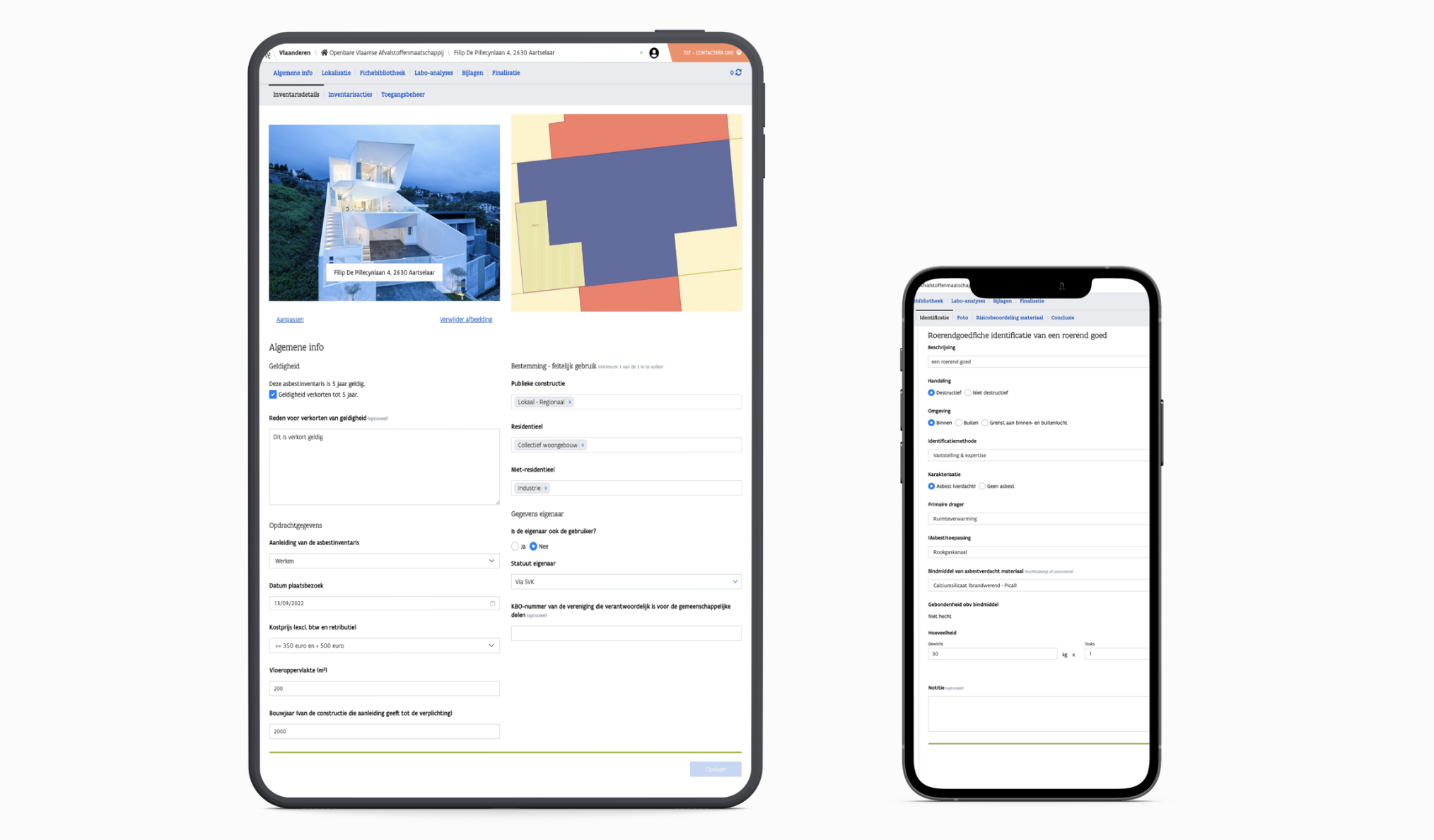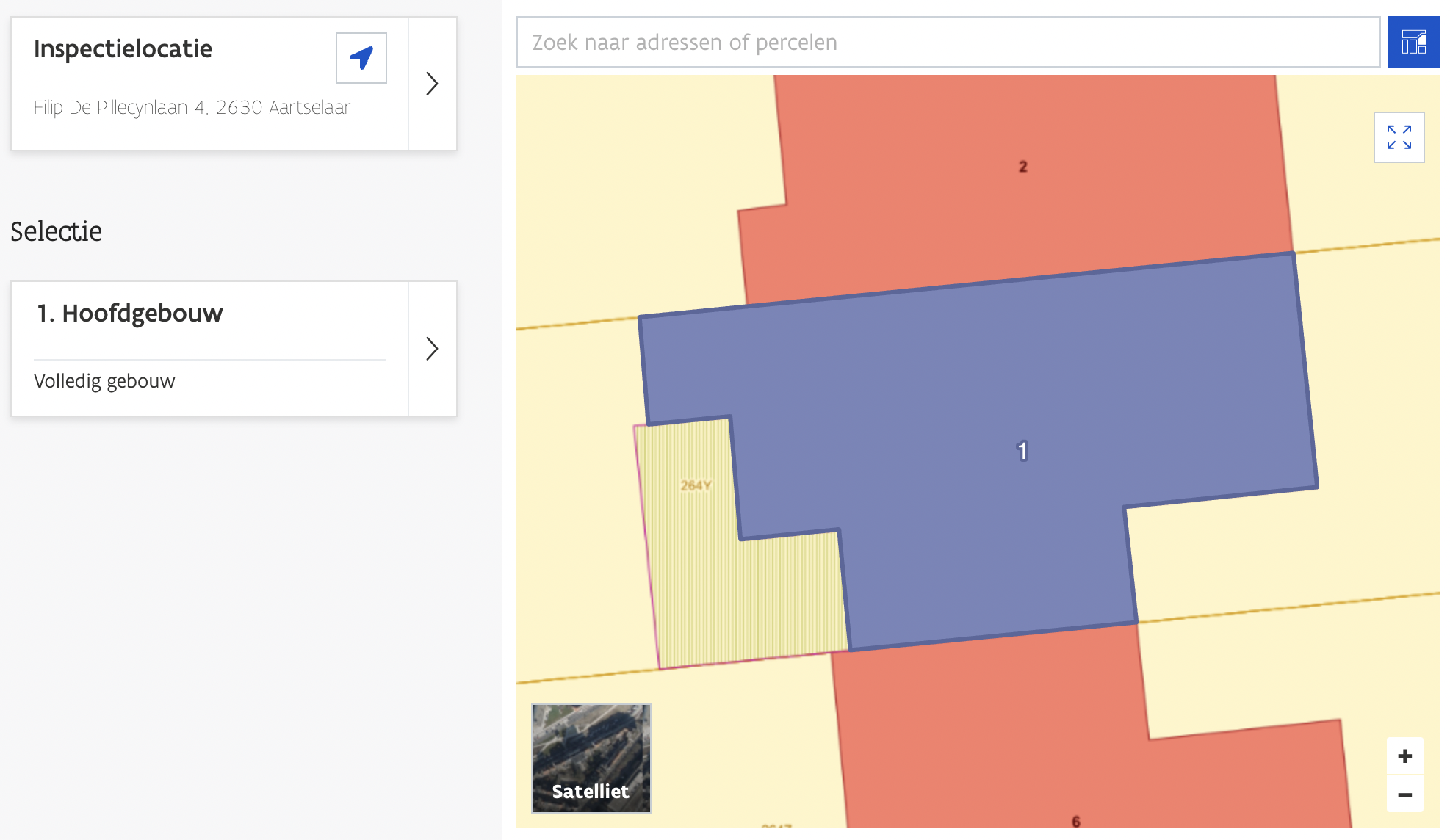Mobile-first app maps out asbestos for OVAM

OVAM, the Openbare Vlaamse Afvalstoffenmaatschappij (Public Waste Agency of Flanders) is committed to the sustainable management of waste and materials in Flanders. As part of the Flemish Environment, Nature and Energy policy area, the government agency also works to ensure clean soils and healthy groundwater. Another OVAM activity revolves around fostering the phasing out of asbestos in Flemish buildings.
The challenge: to underpin the asbestos certificate for homes with an inventory
Even though asbestos is not quite visible to the naked eye, it is carcinogenic. The use of materials containing asbestos in buildings has been banned since 2000, even though the hazard continues to exist in a lot of older constructions. To tackle this problem and to drive down the amount of asbestos that is still out there, since 23 November 2022, building owners who are selling their property (built before 2001) need to have an asbestos certificate. This certificate specifies whether or not the home is asbestos-safe. By 2032, all homes built before 2001 need to have this certificate. OVAM’s landing page has full details about this certificate.
Obviously, the inspection to establish whether the home contains asbestos is carried out on-site. As part of their inspections, the asbestos experts need to gather the details of all asbestos materials encountered, upload photos and plans of the buildings they have examined whilst ensuring the asbestos materials can be accurately pin-pointed on these plans.
Our solution: an innovative mobile-first application that also works offline
Today, asbestos experts are travelling the length and breadth of Flanders, tablet in hand, storing all information thanks to a mobile-first app we devised for OVAM. Click here to find out more about the concept and the way in which the app was designed In practical terms, we needed to reckon with the fact that the app was to be mainly used on the ground. Which is why we built a progressive web app (PWA) using React. This allows users to install the website on their tablet as an app.

As asbestos experts often find themselves calling round to locations with limited to no mobile signal, the frontend application also enables them to effortlessly upload plans and photos without being connected to the internet. As soon as the device picks up a signal and is connected to a network again, the app itself will synchronise all data with the backend. Using so-called ‘Optimistic UI’ principles allows the app to swiftly respond at all times, without having a wait for feedback from the backend.
Needless to say, a considerable amount of data is generated when compiling an inventory of the asbestos present in buildings. Ultimately, this information needs to reach the buildings’ owners who requested the certificate. Which is why we have enabled the asbestos certificate to be digitally shared as a PDF file. Since a lot of data are dynamic in nature, it was quite a challenge to gather all data and visual elements in a single document. As a result, large asbestos certificates can soon run into a few hundred pages. In order to implement the whole thing, we used Docmosis.
Integration with authentication portal and GIS data
So as to correctly identify the app’s end users – chiefly employees of Belgian organisations – and to give them proper access authorisation, the solution has been integrated with Authenticatie Vlaanderen (Authentication Flanders). This is the Flemish authentication portal where users can sign in using either their eID, Itsme or federal tokens. The portal also allows us to implement a comprehensive roles and authorisations system. Under the hood, we opted for the OpenID standard and, using Keycloak, we set up an authentication façade that has since been taken up by several apps at OVAM.

The extensive use of OpenLayers also sees the solution integrate with the Flemish GIS data, a geographic information system of the nation’s entire real estate patrimony. Using maps, this allows users to locate the building they wish to inventory, adding it to the list with a simple click. The app even allows users to request automatic address suggestions. If no plans are available, based on the GIS data, the app itself can convert the outline of a building into an image. The experts too can easily add and draw interior walls themselves with consummate ease.
Certification platform
Before the app went live, the regulations governing the asbestos phase-out policy had to be approved. In order to determine which rules we were able and which rules we were unable to support in the app, we spent three years working very closely with OVAM and the asbestos experts. Moreover, the new legislation opens prospects for two new players on the market. For one thing, companies are being set up that have the relevant asbestos expertise and employ certified experts. For another thing, OVAM-accredited institutions are needed that will issue these certificates upon completion of the relevant training courses.
Which is why, in addition to the app, we have also developed a certification platform. This will enable institutions to manage experts’ pathways. For instance, this could include the registration of candidates, training courses they have taken and exams they have sat. Only when someone has registered and been awarded a certificate is this person authorised to compile an asbestos inventory through the application.
What’s next? 🚀
Over the months and years ahead, the app will be further enhanced and expanded. In doing so, we are not only supporting asbestos experts in preparing certificates, we are also helping Flanders achieve its self-proclaimed mission to make all buildings in Flanders asbestos-safe by 2040.
Related customer success stories
- Development of a district work voucher platform for VDAB
VDAB called on the specialists of ACA Group to develop their new platform for the management and issuance of district work vouchers.
- Make the energy flow, 100% online
This energy supplier runs everything online. So they needed a website totally ready for hits. The ACA development made sure the architecture was solid, inside and out.
- Reporting tool in Python for all branches of VCST
For VCST we developed a reporting tool in Python that is used in all offices around the world.


